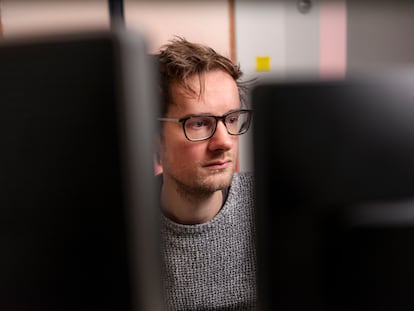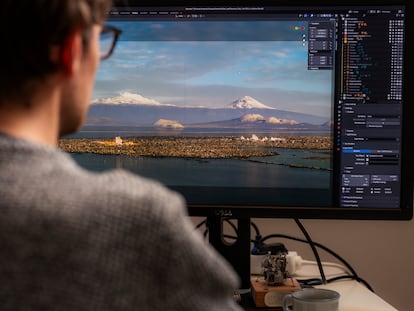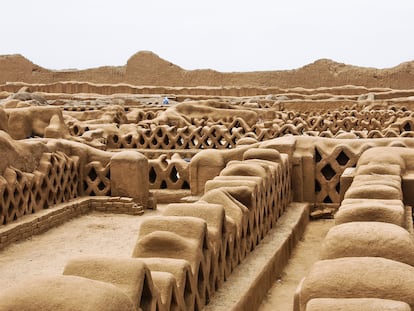The lost city of Tenochtitlan, recreated from the apartment of a Dutch computer scientist
Thomas Kole had never set foot in Mexico until now. But the story captivated him and from his home in the Netherlands he created the most faithful 3D portrait to date of the legendary Aztec metropolis

All cities contain within them those that preceded them. One can try to trace them through their vestiges, but it is almost always an exercise reserved for the pleasure of the imagination. That is what 29-year-old Dutch technical artist Thomas Kole was doing — walking virtually through the streets of Mexico City — when he realized that nothing he observed would ever be enough to reconstruct that other city buried under today’s: the great Tenochtitlan, capital of the Aztec empire. Far from abandoning his endeavor, he dedicated himself to it completely and, a year and a half later, he has presented the most faithful 3D reconstruction of the ancient metropolis known to date. Without leaving home, Kole crossed the Atlantic to the past and landed, with the help of technology, in the Americas of 1518, the culminating moment in pre-Hispanic history.

“It was totally unexplored territory for me. I don’t even know how I came across the topic, there was no catalyst. But I think once you read something about it, you’re hooked. The idea settled in my head and it was impossible to get it out,” says the artist. Despite dedicating himself to programming, history has always intrigued him, and a couple of clicks here and there led to a project that made his fascination material. “Tenochtitlan surprised me in many aspects: its size, its organization, its structure. Very beautiful things have been written about it. Its natural condition, on a lake and surrounded by volcanic mountains, really piques the imagination.”
Kole had never traveled to Mexico until this week. Nor does he speak Spanish. But in his obsession resonate the verses that Nicaraguan poet Ernesto Cardenal — also a foreigner and captivated, like him, by the beauty of that city on the lake — wrote many decades ago: “But how to write anew the hieroglyph / How to paint the jaguar anew, How to overthrow the tyrants? / How to build our tropical acropolis anew?” Answering these questions almost literally, as Kole set out to do, required large doses of documentation and an effort to remove the preconceived ideas that filter, in his view, education and archives in which the European view prevails.

For a year and a half he combined the development of this project, carried out at his home in Amersfoort in his spare time, with his work for a company that develops installations and interactive games for museums and other venues. History and his knowledge of video games combined to keep the project within manageable parameters: “Games need to be fast, optimization is very important, so I used a lot of their tricks. There’s a lot of sense of detail that only works at drone distance. If you get up close, it looks like an impressionistic painting.” There were at least five versions of every element featured in the project prior to the final one being settled upon.
The result is an impressive journey through time. The Popocatépetl and Iztaccihuatl volcanoes crown a landscape that is rarely visible from the city due to pollution. The extinct sacred precinct, returned to its original state along with its imposing Templo Mayor — the most difficult part for Kole because of its symbolic value and centrality — captures the gaze of a city built around it with rectangular plots that reveal the hierarchies of the time. The 200,000 inhabitants of the metropolis were divided into neighborhoods with their own markets, schools, and workshops, in the style of the colonies of today’s cities. Like little ants on the ground, one can see them, with their shopping baskets and cotton clothes, strolling through the streets of this reconstructed empire.
“Dividing it into grids makes sense when you’re on the water, because you need to actively create the terrain; you can’t shove a stick in and draw a line on the sand,” says Kole, who remains doubtful about the placement of some elements. “I’m still trying to figure out why some streets are arranged in a completely random direction. I think it could be due to the impact of the natural flow of water, which is very difficult to redirect, but I’m not sure.”

His doubts are added to those of the experts. He thought his task would be to transfer to virtual reality an ancient map on which there was some consensus, but no such map exists. “I soon realized that nobody agrees on anything,” he sums up. So, despite the archaeological and historical sources and a multitude of plans, the greatest weight fell on direct consultations with specialists, to whom he showed his proposals. “If someone were to do the reconstruction in 10 years, it would surely be different because there would be new information,” he acknowledges.
Kole wanted to involve the Mexican people in some way, and as such he contacted several collaborators, always remotely, just like this interview, conducted from Mexico. The three local artists who worked with him were in charge of photographing the current state of the city, Andrés Semo García; of producing the glyph of Tenochtitlan that opens the web page, Chicome Itzcuintli Amatlapalli; and translating the descriptions that accompany the images from English to Spanish, as well as the main variant of Náhuatl, the most widespread Indigenous language in Mexico; Rodrigo Ortega Acoltzi. “I was surprised how, when I translated them, some paragraphs were half as long, because Náhuatl is very efficient at talking about certain things, and others were twice as long, because it was totally inefficient,” says Acoltzi. Of this ancient but new language for him, he was particularly attracted to the prefix “po,” which means smoke, and which “is reproduced in many forms”: Popocatépetl, chipotle...
Kole’s friends and co-workers find it funny that “a random guy” from the Netherlands “did something like that,” although for him, the connection between Náhuatl and Dutch is much closer than it seems and is present in many everyday words, such as tomato or avocado. This project was born out of pure inspiration and Kole doesn’t know when, or what, the next one will be, or what country or era it will take him to. For the moment, he will present the project for the first time on February 16, in the city that today contains the one that moved him. That other foreigner in love with Mexico, Cardenal, wrote: “Tenochtitlan is there, even without adobes / Even turned into a network of holes / It remains in the vision of its poets.”
Sign up for our weekly newsletter to get more English-language news coverage from EL PAÍS USA Edition
Tu suscripción se está usando en otro dispositivo
¿Quieres añadir otro usuario a tu suscripción?
Si continúas leyendo en este dispositivo, no se podrá leer en el otro.
FlechaTu suscripción se está usando en otro dispositivo y solo puedes acceder a EL PAÍS desde un dispositivo a la vez.
Si quieres compartir tu cuenta, cambia tu suscripción a la modalidad Premium, así podrás añadir otro usuario. Cada uno accederá con su propia cuenta de email, lo que os permitirá personalizar vuestra experiencia en EL PAÍS.
¿Tienes una suscripción de empresa? Accede aquí para contratar más cuentas.
En el caso de no saber quién está usando tu cuenta, te recomendamos cambiar tu contraseña aquí.
Si decides continuar compartiendo tu cuenta, este mensaje se mostrará en tu dispositivo y en el de la otra persona que está usando tu cuenta de forma indefinida, afectando a tu experiencia de lectura. Puedes consultar aquí los términos y condiciones de la suscripción digital.
More information
Archived In
Últimas noticias
Most viewed
- Sinaloa Cartel war is taking its toll on Los Chapitos
- Oona Chaplin: ‘I told James Cameron that I was living in a treehouse and starting a permaculture project with a friend’
- Reinhard Genzel, Nobel laureate in physics: ‘One-minute videos will never give you the truth’
- Why the price of coffee has skyrocketed: from Brazilian plantations to specialty coffee houses
- Silver prices are going crazy: This is what’s fueling the rally











































